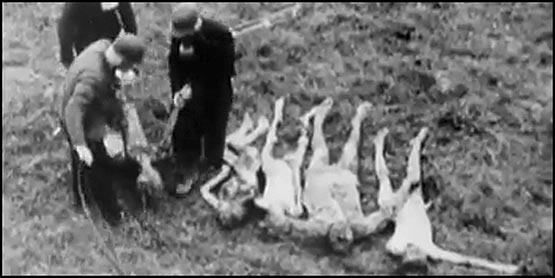Psychiatry: Fake science. Real harm.
German psychiatry: murdering back then, still torturing now

The Racism of Psychiatry and the Deadly Connection
between German and International Psychiatry
between German and International Psychiatry

The murder of human beings in German institutions and the role psychiatry played in these murders can only be understood in the context of the “scientific administration” of populations. This conception of “scientific management” developed at the end of the 19th and beginning of the 20th century and was differently realized depending on national and political contexts. In all Western states, governments focused more and more on two questions:
by Thomas Foth
on the one hand, how could the health and efficiency of the nation be increased, and, on the other hand, how could habits, life styles and activities of individual citizens be influenced in such a way that they become more efficient. Psychiatry played a decisive role because it perceived these two dimensions as part of its responsibility, as can be seen in the mental hygiene movement. From the moment governing was about the “good management” of the population, it had to be based on scientific expertise; a “government of experts” should, based on objective and neutral knowledge, scientifically administer the social order. From this perspective, the individual was perceived as part of a social machine with certain responsibilities and the state had the right to intervene in the lives of individuals if this would serve the wellbeing of the nation.
This conceptualization was also the basis of the Nazi regime. Scientific expertise should serve as the basis for political, rational decision-making processes. This can be seen in projects like German cancer research, or the war Nazi physicians waged against smoking, their fight against the harmful effect of asbestos, or their criticisms of the excessive use of medications and the dangers of X-ray irradiation, etc.
For example, sterilizations were nothing more than a kind of police intervention and a form of social administration. Eugenics, of which sterilizations were a part, became a Nazi idea of preventive medicine that was in line with what was happening in other countries. During the 20th century no clear demarcation existed worldwide between eugenics and preventive medicine, which is to say, between the quest for health and the elimination of the “unfit.” The killing of humans during the Nazi era eventually was only one aspect of politics aimed to increase the efficiency of life as such. This kind of power was a complex interplay of the management of life and death. The US became a pioneer in the legal implementation of compulsory sterilization as a central means in programs to reduce the reproduction of the “unfit.”
By 1907, the state of Indiana legalized forced sterilization, the first state worldwide to do so. Between 1909 and 1939, approximately 30 federal states implemented similar laws. After many of these laws were successfully challenged in the courts, Harry Hamilton Laughlin, in cooperation with jurists, drafted a model sterilization law that eventually became the template for the Nazi German “Rassen-hygiene” [racial hygiene] law in 1934. In the decades leading up to World War II approximately 60,000 humans were sterilized by force in the US. In the Canadian province of Alberta, a similar law that was implemented in 1928 and persisted till 1988 enabled the sterilizing of 2,800 people.
In 1910, the US established the Eugenic Record Office (ERO) in Cold Spring Harbor, Long Island, that became the intellectual center for eugenic politics and was particularly important in the context of sterilizations. The genetic and biological research program was led by biologist Charles Davenport who maintained a good relationship with the Deutsche Gesellschaft für Rassenhygiene [German Association for Racial Hygiene]. Harry Hamilton Laughlin, who led the ERO, consistently pursued negative eugenics for more than 20 years, crucially influencing politics around forced sterilization in the US. He was vice-president of the International Congress for Population Science organized by Nazi scientists in 1935 in Berlin, and in 1936 was awarded, together with neurologist John Foster Kennedy, an honorary doctorate at the University of Heidelberg that was conferred by the dean of the Faculty of Medicine and professor for race hygiene Carl Schneider.
Schneider was a scientific advisor jointly responsible for the murder of sick persons under the German T4 program and for forced sterilizations in that country. In his acceptance speech, Laughlin emphasized his great appreciation for the German race hygiene program of the Nazis. Until the 1940s, US eugenicists and psychiatrists maintained far-reaching networks with their German counterparts. This is not to say that criticism against eugenic policies did not exist in the US, particularly toward the end of the 1930s when eugenic discourse increasingly merged with antisemitism (which left representatives like Laughlin unimpressed). However, nobody in the US scientific community publically and uncompromisingly criticized either Nazi eugenics or so-called euthanasia.
This conceptualization was also the basis of the Nazi regime. Scientific expertise should serve as the basis for political, rational decision-making processes. This can be seen in projects like German cancer research, or the war Nazi physicians waged against smoking, their fight against the harmful effect of asbestos, or their criticisms of the excessive use of medications and the dangers of X-ray irradiation, etc.
For example, sterilizations were nothing more than a kind of police intervention and a form of social administration. Eugenics, of which sterilizations were a part, became a Nazi idea of preventive medicine that was in line with what was happening in other countries. During the 20th century no clear demarcation existed worldwide between eugenics and preventive medicine, which is to say, between the quest for health and the elimination of the “unfit.” The killing of humans during the Nazi era eventually was only one aspect of politics aimed to increase the efficiency of life as such. This kind of power was a complex interplay of the management of life and death. The US became a pioneer in the legal implementation of compulsory sterilization as a central means in programs to reduce the reproduction of the “unfit.”
By 1907, the state of Indiana legalized forced sterilization, the first state worldwide to do so. Between 1909 and 1939, approximately 30 federal states implemented similar laws. After many of these laws were successfully challenged in the courts, Harry Hamilton Laughlin, in cooperation with jurists, drafted a model sterilization law that eventually became the template for the Nazi German “Rassen-hygiene” [racial hygiene] law in 1934. In the decades leading up to World War II approximately 60,000 humans were sterilized by force in the US. In the Canadian province of Alberta, a similar law that was implemented in 1928 and persisted till 1988 enabled the sterilizing of 2,800 people.
In 1910, the US established the Eugenic Record Office (ERO) in Cold Spring Harbor, Long Island, that became the intellectual center for eugenic politics and was particularly important in the context of sterilizations. The genetic and biological research program was led by biologist Charles Davenport who maintained a good relationship with the Deutsche Gesellschaft für Rassenhygiene [German Association for Racial Hygiene]. Harry Hamilton Laughlin, who led the ERO, consistently pursued negative eugenics for more than 20 years, crucially influencing politics around forced sterilization in the US. He was vice-president of the International Congress for Population Science organized by Nazi scientists in 1935 in Berlin, and in 1936 was awarded, together with neurologist John Foster Kennedy, an honorary doctorate at the University of Heidelberg that was conferred by the dean of the Faculty of Medicine and professor for race hygiene Carl Schneider.
Schneider was a scientific advisor jointly responsible for the murder of sick persons under the German T4 program and for forced sterilizations in that country. In his acceptance speech, Laughlin emphasized his great appreciation for the German race hygiene program of the Nazis. Until the 1940s, US eugenicists and psychiatrists maintained far-reaching networks with their German counterparts. This is not to say that criticism against eugenic policies did not exist in the US, particularly toward the end of the 1930s when eugenic discourse increasingly merged with antisemitism (which left representatives like Laughlin unimpressed). However, nobody in the US scientific community publically and uncompromisingly criticized either Nazi eugenics or so-called euthanasia.
Concentration camp Hadamar after US-Army arrival:
Exhumation of the victims
Source: https://archive.org/details/gov.archives.arc.43452#
Exhumation of the victims
Source: https://archive.org/details/gov.archives.arc.43452#
How far this mutual recognition went and, more importantly, how far the scientific-political programs between the two countries overlapped, becomes obvious in public debates during the decades preceding World War II. These debates between American, British, and German eugenicists concerned the possible use of “lethal chambers” for the murder of “defectives.” The standard textbook at that time, Applied Eugenics, was authored by Paul Popenroe and Roswell H. Johnson, who maintained good relations with German eugenicists and openly supported the Nazi racial program. They concluded that "[f]rom the historical point of view the first method that presents itself is execution. […] Its value in keeping up the standard of the race should not be underestimated" (quoted in Black, 2003: 251). Against this backdrop, the above-mentioned American neurologist Foster Kennedy and American child psychiatrist Leo Kanner both read a paper at the 1941 annual meeting of the American Psychiatric Association (APA)(just before the official end of the “AktionT4”) about the pros and cons of killing persons with a mental disability. Their respective contributions were published in 1942 in the official APA journal, the American Journal of Psychiatry, complemented by an anonymous commentary by the journal’s editors. [Text Foster Kennedy - Text Leo Kanner - Comment by the editor - "The 1942 ‘euthanasia’ debate in the American Journal of Psychiatry" by Jay Joseph, 2005]
At this time, reports in the US already existed about the systematic murder by the Nazis of more than 100,000 humans. At one point in his talk, Kanner even alluded to these revelations. However, they did not hinder Kennedy nor the authors of the commentary to openly advocate for the killing of “feebleminded” children. Kennedy, who since 1940 had been president of the American Neurological Association, was a globally renowned professor at Cornell University and had received an honorary doctorate from the University of Heidelberg. He was a well-known member of the Euthanasia Society in the US and a determined supporter of the murder of persons with mental disabilities. In1939, Kennedy resigned from the Society because he argued that it put too much emphasis on voluntary sterilization. In his 1942 article, he supported a perspective similar to that of Binding and Hochte in their 1920 book, Die Freigabe der Vernichtung Lebensunwerten Lebens [Allowing the Destruction of Life Unworthy of Life]. As Kennedy stated, “euthanasia” should be allowed “for those hopeless ones who should never have been born – Nature’s mistakes.”
At this time, reports in the US already existed about the systematic murder by the Nazis of more than 100,000 humans. At one point in his talk, Kanner even alluded to these revelations. However, they did not hinder Kennedy nor the authors of the commentary to openly advocate for the killing of “feebleminded” children. Kennedy, who since 1940 had been president of the American Neurological Association, was a globally renowned professor at Cornell University and had received an honorary doctorate from the University of Heidelberg. He was a well-known member of the Euthanasia Society in the US and a determined supporter of the murder of persons with mental disabilities. In1939, Kennedy resigned from the Society because he argued that it put too much emphasis on voluntary sterilization. In his 1942 article, he supported a perspective similar to that of Binding and Hochte in their 1920 book, Die Freigabe der Vernichtung Lebensunwerten Lebens [Allowing the Destruction of Life Unworthy of Life]. As Kennedy stated, “euthanasia” should be allowed “for those hopeless ones who should never have been born – Nature’s mistakes.”
Concentration camp Hadamar after US-Army arrival:
Interrogation of the perpetrators
Source: https://archive.org/details/gov.archives.arc.43452#
Interrogation of the perpetrators
Source: https://archive.org/details/gov.archives.arc.43452#
He proposed to have “defective children” examined by a medical board once they achieved the age of 5, and if, after several months and at least 3 examinations the board came to the conclusion that these “defective” children had no hope for a future, it would be “a merciful and kindly thing to relieve that defective – often tortured and convulsed, grotesque and absurd, useless and foolish and entirely undesirable – the agony of living.” The terms Kennedy used in his paper were the standard terms of psychiatric genetics and Nazi literature. Although his “opponent” Kanner argued against the cold-blooded murder of thousands of people, he did so based more on strategic rather than on fundamental considerations. According to Kanner, people with lesser intelligence were necessary for the maintenance of society, because they would perform tasks that “mentally superior” people would not (e.g., garbage collection) thereby freeing “the time and energies of others for tasks which involve planning and creative activities."
However, he agreed with Kennedy that some “idiots and imbeciles cannot be trained in any kind of social usefulness.” Even more important is the commentary by the editors, which clearly demonstrates their agreement with Kennedy and thus, one of the world's most renowned psychiatric journals openly supported the murder of humans with mental disabilities in 1942.
At the moment in the 19th century when the scientific management of the population became the maxim for politics, a decisive development in psychiatric theory also occurred, as Foucault's 1974 work demonstrates. At this point, psychiatry defined the conduct or behavior of the individual as the object of theory, whereby behavior was understood as something permanent. Accordingly, psychiatrists were no longer trying to identify pathological processes within the individual, but rather searched for constant marks that characterized an individual's structure. These marks, or stigmata, not only concerned the dimension of the psyche but could also be found in the body, such as in skull or other organ measurements.
Those deemed aberrant could offer proof of a congenital condition; alterations of the body were interpreted as physical and structural signs for something that was permanent and immutable. From that moment on, psychiatry concentrated on aspects of aberrant or deficient development that were understood as functional imbalances; that is, because the higher instincts were not devel-oped, lower instincts could act unhindered. Categories of “feeble mindedness,” or “idiocy,” etc. therefore became so important for psychiatry because deviant behavior could be explained through congenital dysfunction that interrupted normal development. This in turn enabled the search for abnormal behavior that was no longer perceived as the consequence of pathology but rather of congenital dysfunction.
Related to the latter is the problematizing of groups with abnormalities within the population, like those with agoraphobia (Krafft-Ebing), claustrophobia (Westphal), homosexuality or masochism – all of them not descriptions of symptoms of a disease but syndromes of a stable predisposition for abnormality. Jean-Pierre Falret (1864) and his concept of conditions of deficiency, which psychiatrists used up to Kraeppelin, became the foundation of the abnormal, and up until today, it leads to the question as to which body can produce such a deficiency. The answer lies in the discovery of heredity, or rather in the body of the family and its ancestors.
However, he agreed with Kennedy that some “idiots and imbeciles cannot be trained in any kind of social usefulness.” Even more important is the commentary by the editors, which clearly demonstrates their agreement with Kennedy and thus, one of the world's most renowned psychiatric journals openly supported the murder of humans with mental disabilities in 1942.
At the moment in the 19th century when the scientific management of the population became the maxim for politics, a decisive development in psychiatric theory also occurred, as Foucault's 1974 work demonstrates. At this point, psychiatry defined the conduct or behavior of the individual as the object of theory, whereby behavior was understood as something permanent. Accordingly, psychiatrists were no longer trying to identify pathological processes within the individual, but rather searched for constant marks that characterized an individual's structure. These marks, or stigmata, not only concerned the dimension of the psyche but could also be found in the body, such as in skull or other organ measurements.
Those deemed aberrant could offer proof of a congenital condition; alterations of the body were interpreted as physical and structural signs for something that was permanent and immutable. From that moment on, psychiatry concentrated on aspects of aberrant or deficient development that were understood as functional imbalances; that is, because the higher instincts were not devel-oped, lower instincts could act unhindered. Categories of “feeble mindedness,” or “idiocy,” etc. therefore became so important for psychiatry because deviant behavior could be explained through congenital dysfunction that interrupted normal development. This in turn enabled the search for abnormal behavior that was no longer perceived as the consequence of pathology but rather of congenital dysfunction.
Related to the latter is the problematizing of groups with abnormalities within the population, like those with agoraphobia (Krafft-Ebing), claustrophobia (Westphal), homosexuality or masochism – all of them not descriptions of symptoms of a disease but syndromes of a stable predisposition for abnormality. Jean-Pierre Falret (1864) and his concept of conditions of deficiency, which psychiatrists used up to Kraeppelin, became the foundation of the abnormal, and up until today, it leads to the question as to which body can produce such a deficiency. The answer lies in the discovery of heredity, or rather in the body of the family and its ancestors.
Concentration camp Hadamar after US-Army arrival:
The murderous poison
Source: https://archive.org/details/gov.archives.arc.43452#
The murderous poison
Source: https://archive.org/details/gov.archives.arc.43452#
The theory of inheritance at the time established the fact that specific diseases could cause a disease of the same kind, or of any other kind, in descendants. A vice like excessive alcohol consumption, for example, could cause any form of deviant behavior alcoholism itself, or other diseases like tuberculosis and mental illnesses. Heredity functioned as a “phantasmatic body” that became the cause for any kind of abnormality, either physiological, psychological or behavioral. The theory of degeneration, developed in 1857, emerged at the same time that the neurological models of von Baillarger, Griesinger, Luys and Lucas became prominent – all of them dealing with the question of pathological inheritance.
Degeneration thus became the central theoretical construct in the medicalization of the abnormal. At the moment that psychiatry was able to connect deviant behavior with a condition that was simultaneously hereditary and definitive, psychiatry was no longer interested in searching for cures. Incurability had been something that existed at the margins of insanity, but from the moment that insanity became the condition of the abnormal, which, through the biography of the individual, was connected to its assumed heredity, therapeutic approaches disappeared. Psychiatry could only assume a kind of protective function, protecting society from the dangers it apparently faced by those who were in a condition of abnormality. Psychiatry assumed the role of safeguarding societal order, and it became a science of the social defense of society and the biological protection of the species, thus achieving the summit of psychiatry's power.
With this assumption of societal control, and along with the concept of degeneration and analyses about heredity, psychiatry produced a new kind of racism that was very different from traditional, “ethnic” racism. The racism of psychiatry was a racism against the abnormal, against the individual that was understood as the bearer of stigmata or deficiencies they could randomly pass on to their descendants – with unforeseeable consequences. This racism aimed to identify dangers in the interior of a population, this is to say, to filter out all dangerous individuals within a given society. That this form of psychiatric thinking in Germany spontaneously functioned so successfully within Nazism should not be surprising. The new racism of the 20th century, this neo-racism that served as the means for the interior defense of society against the abnormal, developed first in psychiatry. Nazism just merged its ethnic, antisemtic racisms with this new racism that was already prevalent in the 19th century.
These new forms of racism that emerged in Europe and the US toward the end of the 19th century must historically be located within psychiatry. If the international psychiatric community wants to seriously engage with the murders committed under the name of German psychiatry, it needs first of all to acknowledge that psychiatry from the 19th century on essentially functioned as a mechanism of social defense. The common origin of modern psychiatry in Germany and elsewhere lies in the assumption that those deemed degenerate were considered bearers of danger and not able to be cured.
Degeneration thus became the central theoretical construct in the medicalization of the abnormal. At the moment that psychiatry was able to connect deviant behavior with a condition that was simultaneously hereditary and definitive, psychiatry was no longer interested in searching for cures. Incurability had been something that existed at the margins of insanity, but from the moment that insanity became the condition of the abnormal, which, through the biography of the individual, was connected to its assumed heredity, therapeutic approaches disappeared. Psychiatry could only assume a kind of protective function, protecting society from the dangers it apparently faced by those who were in a condition of abnormality. Psychiatry assumed the role of safeguarding societal order, and it became a science of the social defense of society and the biological protection of the species, thus achieving the summit of psychiatry's power.
With this assumption of societal control, and along with the concept of degeneration and analyses about heredity, psychiatry produced a new kind of racism that was very different from traditional, “ethnic” racism. The racism of psychiatry was a racism against the abnormal, against the individual that was understood as the bearer of stigmata or deficiencies they could randomly pass on to their descendants – with unforeseeable consequences. This racism aimed to identify dangers in the interior of a population, this is to say, to filter out all dangerous individuals within a given society. That this form of psychiatric thinking in Germany spontaneously functioned so successfully within Nazism should not be surprising. The new racism of the 20th century, this neo-racism that served as the means for the interior defense of society against the abnormal, developed first in psychiatry. Nazism just merged its ethnic, antisemtic racisms with this new racism that was already prevalent in the 19th century.
These new forms of racism that emerged in Europe and the US toward the end of the 19th century must historically be located within psychiatry. If the international psychiatric community wants to seriously engage with the murders committed under the name of German psychiatry, it needs first of all to acknowledge that psychiatry from the 19th century on essentially functioned as a mechanism of social defense. The common origin of modern psychiatry in Germany and elsewhere lies in the assumption that those deemed degenerate were considered bearers of danger and not able to be cured.
The author, Dr. Thomas Foth
is Assistant Professor at the School of Nursing at the University of Ottawa, Canada, and as nursing historian particularly interested in the history of psychiatric care in an international comparison. He has written a book on the involvement of nurses in the murder of psychiatric patients in psychiatry in Hamburg and is currently researching the use of electroshocks and the amalgamation of management and nursing in Canadian psychiatry.
E-Mail: tfoth@uottawa.ca
is Assistant Professor at the School of Nursing at the University of Ottawa, Canada, and as nursing historian particularly interested in the history of psychiatric care in an international comparison. He has written a book on the involvement of nurses in the murder of psychiatric patients in psychiatry in Hamburg and is currently researching the use of electroshocks and the amalgamation of management and nursing in Canadian psychiatry.
E-Mail: tfoth@uottawa.ca

or order print versions for further distribution here:
- The Racism of Psychiatry and
the Deadly Connection between German and International Psychiatry by Thomas Foth - The Missing Link
- The Proof
- Psychiatrists recommend to you wonderful Berlin...
- Quote by Prof. Thomas Szasz
- Coercive psychiatry a torture system by Alice C. Halmi
- Why "mental illness" does not exist
- Coercive psychiatry can be put to a stop
- Quotes by Gert Postel, "The imposter among imposters".
- Easily make a protest poster


